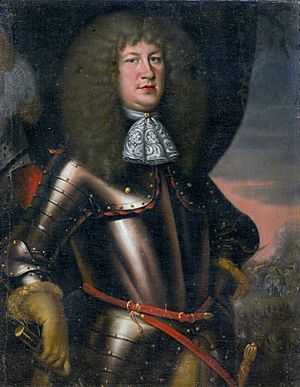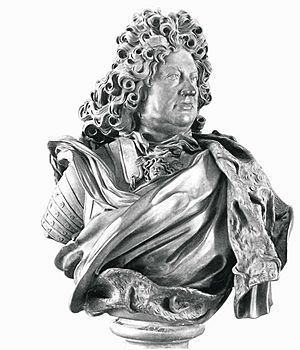Frederick II, Landgrave of Hesse-Homburg facts for kids
Quick facts for kids
Frederick II, Landgrave of Hesse-Homburg
|
|
|---|---|

Portrait by Pieter Nason
|
|
| Born | 30 March 1633 Homburg |
| Died | 23 January 1708 (aged 74) Homburg |
| Noble family | House of Hesse |
| Spouse(s) |
|
| Issue Detail |
|
| Father | Frederick I, Landgrave of Hesse-Homburg |
| Mother | Margaret Elisabeth of Leiningen-Westerburg |
| Signature | |
Frederick II of Hesse-Homburg (also known as the Prince of Homburg) was an important leader born on March 30, 1633. He became the Landgrave of Hesse-Homburg, a small state in Germany. Frederick was also a very successful general who fought for both Sweden and Brandenburg. Today, he is best known as the hero of a famous play called Der Prinz von Homburg by Heinrich von Kleist. He passed away on January 24, 1708.
Contents
Life of Frederick II
Early Years and Education
Frederick was born in Homburg, which is now called Bad Homburg vor der Höhe. He was the youngest of seven children. His father, Frederick I, Landgrave of Hesse-Homburg, died when Frederick was only five years old. His mother, Countess Margaret Elisabeth of Leiningen-Westerburg, then raised him.
Frederick was taught by private teachers alongside his cousins. In 1648, he broke his leg and had to rest for a while. When a famous general, Henri de la Tour d'Auvergne, Vicomte de Turenne, came near Homburg, Frederick's mother sent him to talk to the general. She wanted to keep Homburg safe. Turenne was so impressed by young Frederick that he wanted him to join his army right away. However, Frederick's mother did not agree to this plan.
When he was 16, Frederick traveled through Italy and France. This was a common trip for young nobles called the "Grand Tour." He then went to the University of Geneva. While there, he focused on learning practical skills like dancing, riding, and fencing. He also improved his French language skills.
A Career in the Military
Since his older brothers would inherit the family lands, Frederick chose to become a soldier. In 1654, he joined the army of the King of Sweden, Charles X Gustav of Sweden, as a colonel.

In 1659, during a battle in Copenhagen, Frederick was badly hurt. His lower right leg had to be removed. After this, he was promoted to major-general and used a wooden leg for the rest of his life. King Charles X wanted Frederick to govern Livonia, but the king died soon after. So, Frederick left the Swedish army in 1661.
That same year, he married Margareta Brahe, a wealthy Swedish widow. She died in 1669. With her money, Frederick bought land in Brandenburg. He became good friends with the Elector Friedrich Wilhelm I of Brandenburg. In 1670, Frederick married the Elector's niece, Princess Luise Elisabeth von Kurland. He also joined the Brandenburg army as a general. In 1672, he was put in charge of all Brandenburg's forces.
Frederick fought in the Franco-Dutch War in 1672 and 1674. He fought against the French army in Alsace. In 1675, during the Swedish invasion, he led the Brandenburg cavalry. In the Battle of Fehrbellin, he attacked the Swedish army without waiting for orders. This bold move caused heavy losses for the Swedes and helped Brandenburg win the battle. However, the Elector was not pleased that Frederick acted without orders. From 1676 to 1678, he fought in other campaigns and helped negotiate a peace treaty.
Becoming Landgrave of Hesse-Homburg
After leaving the military, Frederick lived in Brandenburg. His older brother, Georg Christian, Landgrave of Hesse-Homburg, had borrowed money and put the land of Hesse-Homburg up as collateral. Frederick paid off this debt and moved back to Homburg. In 1681, after another brother, Wilhelm Christoph of Hesse-Homburg, died, Frederick became the ruler as Frederick II. He had to give back some land that his brother had taken, but he received money in return.
Frederick had the beautiful Baroque Schloss Bad Homburg palace built. He also tried to help the local economy by starting a glass factory and a salt-making plant, but these were not very successful. However, he was very successful in helping Huguenot and Waldensian refugees from France settle in towns like Friedrichsdorf. His court alchemist even made him a special prosthetic leg with springs and silver parts. This is why he was sometimes called "the Landgrave with the silver leg."
In 1690, his second wife died. They had 12 children together. When he was 59, Frederick married for a third time to Sophie Sybille von Leiningen-Westerburg. She was related to his mother's family. They had three more children.
Frederick died in Homburg in 1708, likely from pneumonia. He had just returned from a trip to meet Charles XII, King of Sweden, in Leipzig.
Family and Children
Frederick II was married three times during his life.
His first marriage was in 1661 to Countess Margarethe Brahe. She passed away in 1669, and they did not have any children.
In 1670, he married Princess Louise Elisabeth of Courland. They had many children together:
- Charlotte Dorothea Sophia (1672–1738)
- Frederick III Jacob (1673–1746), who became the next Landgrave of Hesse-Homburg.
- Karl Christian (1674–1695), who died in battle.
- Hedwig Luise (1675–1760)
- Philipp (1676–1706), who also died in battle.
- Wilhelmine Maria (1678–1770)
- Eleonore Margarete (1679–1763)
- Elisabeth Juliana Francisca (1681–1707)
- Johanna Ernestine (1682–1698)
- Ferdinand (born and died 1683)
- Karl Ferdinand (1684–1688)
- Casimir William (1690–1726)
After his second wife died in 1690, Frederick married Countess Sophie Sybille of Leiningen-Westerburg in 1691. They had three more children:
- Ludwig Georg (1693–1728)
- Friederike Sophie (1693–1694)
- Leopold (born and died 1695)
See also
 In Spanish: Federico II de Hesse-Homburg para niños
In Spanish: Federico II de Hesse-Homburg para niños

